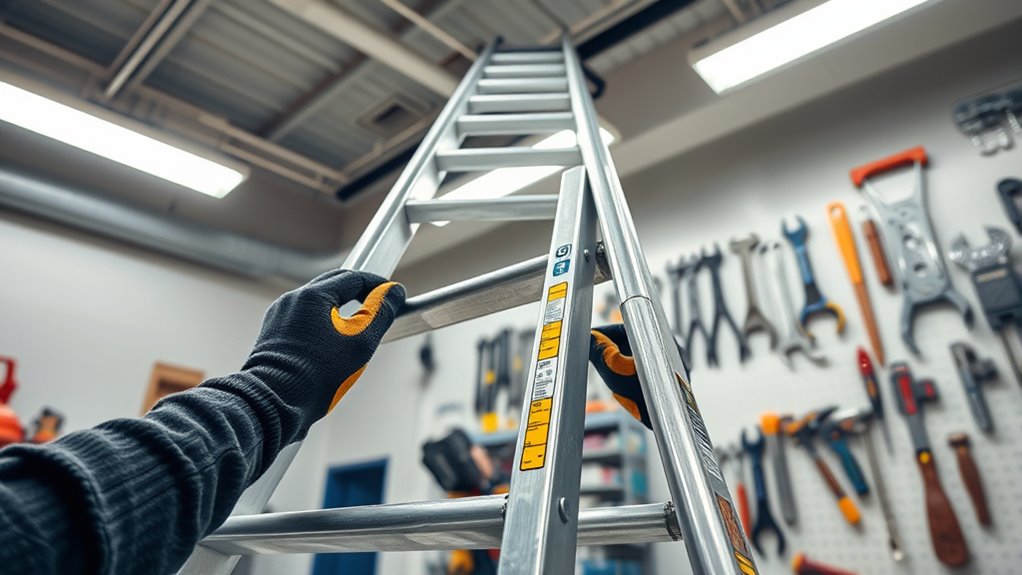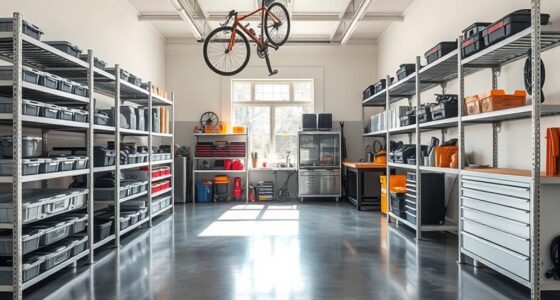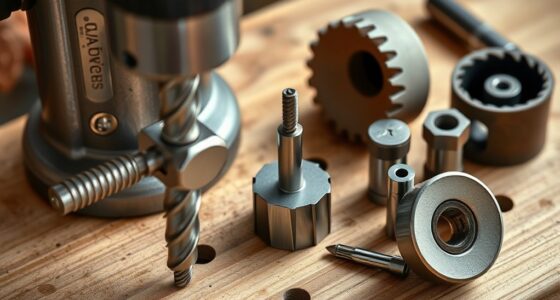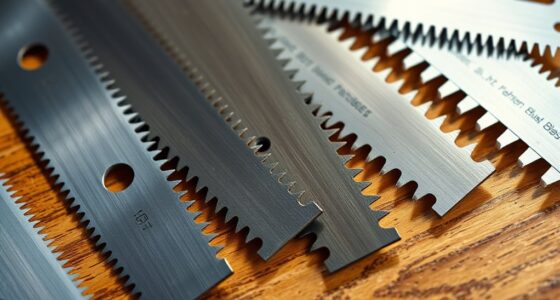To choose and use ladders safely, identify the right type for your task—whether a step, extension, or folding ladder—consider the material for electrical safety, and verify it meets safety standards. Assess your work height, stability needs, and weight capacity, then inspect and maintain your ladder regularly. Use proper techniques like maintaining three points of contact, check environmental conditions, secure your footing, and wear safety gear. For detailed tips on every step, keep exploring; your safety depends on it.
Key Takeaways
- Assess work height, weight capacity, and stability needs to select the appropriate ladder type and size.
- Inspect the ladder regularly for damage, corrosion, and proper functioning before use.
- Ensure the ladder is placed on stable, level ground and secured before climbing.
- Maintain three points of contact and avoid leaning sideways while ascending or descending.
- Follow environmental safety practices, including checking weather conditions and using adequate lighting.
Understanding Different Types of Ladders

To choose the right ladder, you first need to understand the different types available. There are various types of ladders, each suited for specific tasks. Step ladders are self-supporting and ideal for indoor use or tasks at low heights. Extension ladders are versatile, adjustable, and perfect for reaching higher places like roofs or tall trees. Folding ladders combine portability with functionality, making them great for frequent use. When considering ladder materials, options include aluminum, fiberglass, and wood. Aluminum ladders are lightweight and durable but conduct electricity, so they’re not suitable for electrical work. Fiberglass ladders are heavy but non-conductive, offering safety around electricity. Wood ladders are sturdy and non-conductive but require more maintenance. Understanding these types of ladders and materials helps you choose the best tool for your needs. Additionally, selecting a ladder with appropriate contrast ratio ensures better visibility and safety in various lighting conditions.
Assessing Your Work Requirements
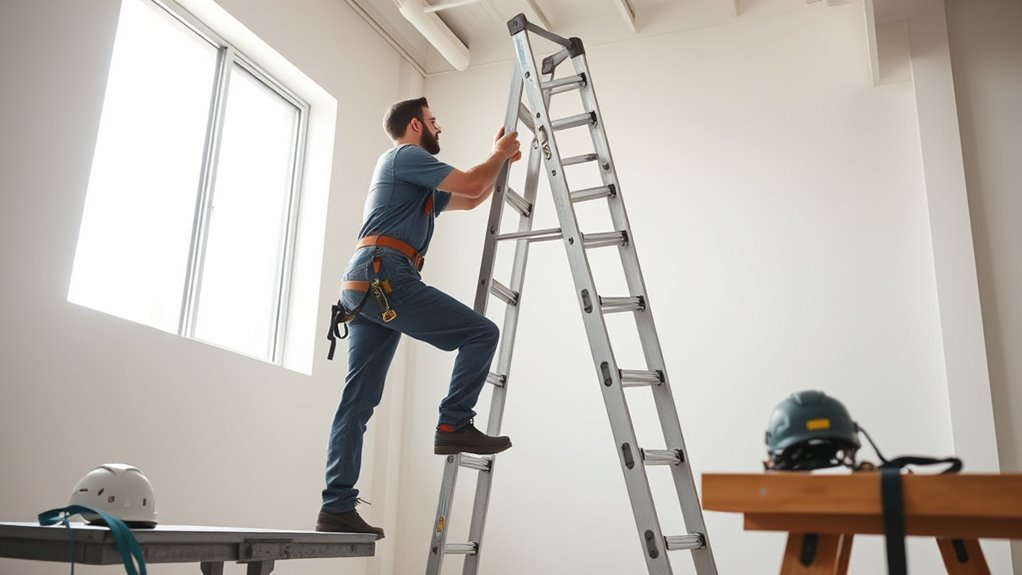
Before selecting a ladder, you need to clearly define your work requirements. Determine your work height to ensure the ladder extends safely above your task, giving you enough reach without overextending. Consider the weight capacity of the ladder, accounting for your weight plus any tools or materials you’ll carry. If you’re working with heavy tools or supplies, choose a ladder rated for higher weight capacity to ensure safety. Assess whether your work requires stability for standing or climbing, and think about how much movement you’ll need. Knowing these factors helps you pick the right ladder that matches your work height and weight capacity, reducing the risk of accidents or ladder failure. Proper assessment keeps your work efficient and safe, especially when considering ladder safety standards and guidelines to prevent falls.
Selecting the Appropriate Ladder Height

How do you choose the right ladder height for your task? Start by considering the ceiling clearance and the height you need to reach. Your ladder should extend at least three feet above the highest point you’ll work on to guarantee safe access. For example, if you need to reach a ceiling that’s eight feet high, select a ladder that’s at least 10 feet tall. Avoid using a ladder that’s too short, which forces you to stand on the top rungs or lean dangerously. Conversely, don’t choose a ladder that’s excessively tall, as it can be unwieldy and harder to stabilize. Proper ladder height ensures stability, safety, and ease of use, making your task safer and more efficient. Always measure your workspace carefully before selecting your ladder. Proper ladder selection is crucial to prevent accidents and ensure a secure working environment.
Checking for Safety Certifications and Quality Standards
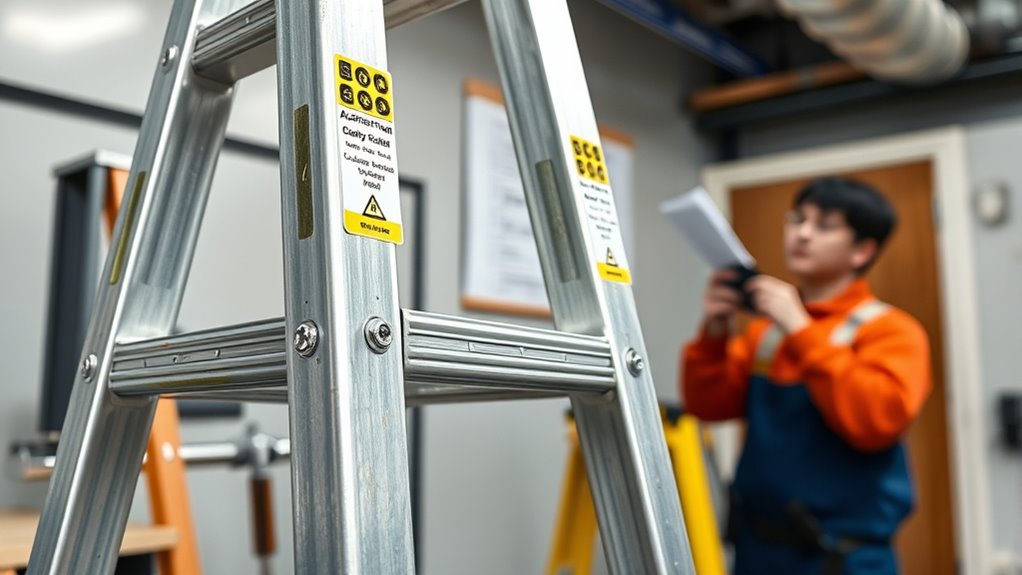
Ensuring your ladder meets safety certifications and quality standards is a vital step in choosing the right equipment. Look for ladders that have been tested and certified by recognized organizations, such as OSHA or ANSI. These safety certifications verify that the ladder meets strict safety requirements. Additionally, check for adherence to quality standards set by industry authorities, which guarantee durability and reliable performance. Always review labels and manufacturer details to confirm certifications are current and valid. Choosing a ladder with proper safety certifications and quality standards reduces the risk of accidents and guarantees your safety during use. Don’t overlook this step—prioritizing certified, high-quality ladders is essential for a safe and effective working experience. Proper certification processes ensure that the ladder has undergone rigorous testing to meet industry safety criteria.
Properly Inspecting and Maintaining Your Ladder
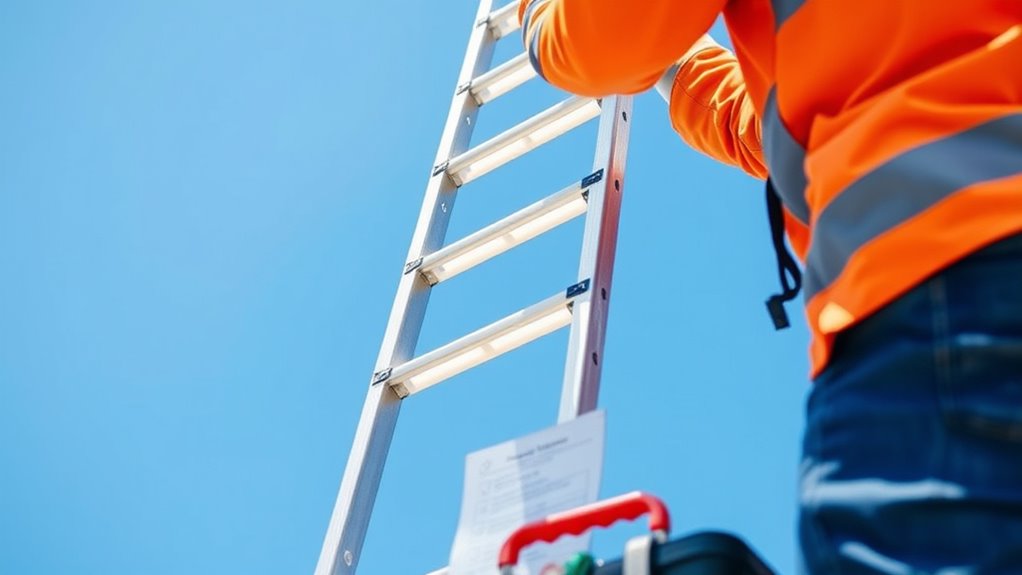
You need to regularly check your ladder for any signs of damage or wear to guarantee safety. Keep it clean and lubricate moving parts to prevent rust and sticking. Store your ladder properly in a dry, secure place to prolong its lifespan and maintain its safety features. Additionally, family photoshoot fails can occur unexpectedly, so being prepared for unforeseen moments can help ensure safety during ladder use.
Regular Visual Inspections
Have you ever considered how frequently inspecting your ladder can prevent accidents? Regular visual inspections are essential for maintaining ladder durability and safety. Check for cracks, dents, or corrosion that compromise structural integrity. Use these visual inspection tips to identify potential issues early. Keep an eye on the joints, rungs, and rails, ensuring they remain secure and free from damage. To help you stay organized, review this quick reference table:
| Inspection Area | What to Look For | Action Needed |
|---|---|---|
| Rungs & Steps | Cracks, looseness | Tighten or replace |
| Rails & Side Pieces | Bends, corrosion | Repair or discard |
| Joints & Connectors | Wear, rust | Lubricate or replace |
Consistent inspections keep your ladder safe and reliable for all tasks. Additionally, choosing a ladder made from sustainable materials can contribute to environmentally responsible practices.
Cleaning and Lubrication
Did you know that regular cleaning and lubrication are essential for keeping your ladder in top condition? Ladder cleaning removes dirt, dust, and debris that can cause slipping or damage over time. Use a damp cloth or mild detergent to wipe down the rungs, side rails, and joints. Once cleaned, applying ladder lubrication ensures moving parts, hinges, and locks operate smoothly. Use a lubricant designed for ladders or metal components, avoiding excess that could attract dirt. Regular ladder lubrication helps prevent rust and corrosion, extending your ladder’s lifespan. Always inspect for signs of wear before and after cleaning, and lubricate as needed. Proper ladder cleaning and lubrication keep your equipment safe, reliable, and ready when you need it. Maintaining ladder safety is crucial for preventing accidents and ensuring longevity.
Proper Storage Practices
Regularly inspecting your ladder during storage helps catch potential issues early. Ensure your storage organization keeps your ladder in a dry, secure place away from hazards. Proper storage not only protects your ladder from damage but also promotes safety. Use space optimization techniques like wall mounts or hooks to keep your ladder upright and accessible, preventing accidental falls or damage. Avoid leaning it against walls or stacking heavy objects on top, which can deform or weaken the structure. Regularly check for corrosion, loose rungs, or other signs of wear before storing. Clean and lubricate moving parts if necessary. Properly maintained and stored ladders last longer and perform reliably, reducing safety risks. Good storage practices are key to maintaining your ladder’s integrity and ensuring safe use every time. Additionally, proper storage practices can help prevent damage caused by environmental factors like humidity or temperature fluctuations, which can compromise the ladder’s safety and longevity.
Safe Techniques for Climbing and Working on a Ladder
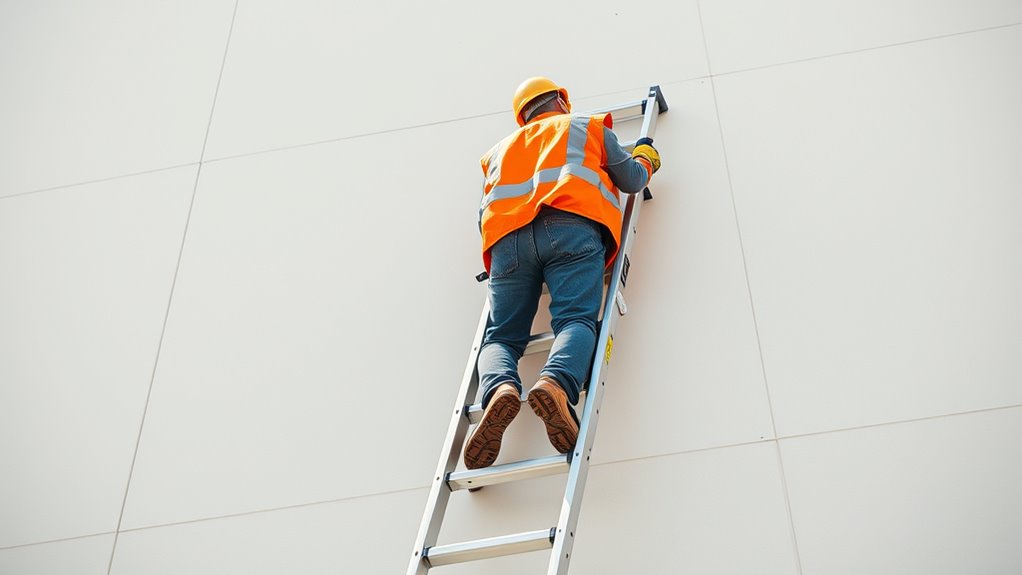
To guarantee safety when climbing and working on a ladder, it’s crucial to follow proper techniques that minimize the risk of falls and injuries. Focus on ladder ergonomics by maintaining three points of contact at all times: two hands and one foot or two feet and one hand. Always check the ladder’s weight limits to prevent overloading. When ascending or descending, face the ladder directly and avoid leaning sideways, which can cause imbalance. Keep your body centered and avoid sudden movements. Before starting work, ensure the ladder is stable and secure. Remember, a proper grip and mindful positioning are key to safe ladder use. Following these steps helps you work efficiently while reducing the chance of accidents. Additionally, understanding the authenticity of your actions can positively influence your safety mindset and decision-making during ladder use.
Environmental Factors to Consider When Using a Ladder
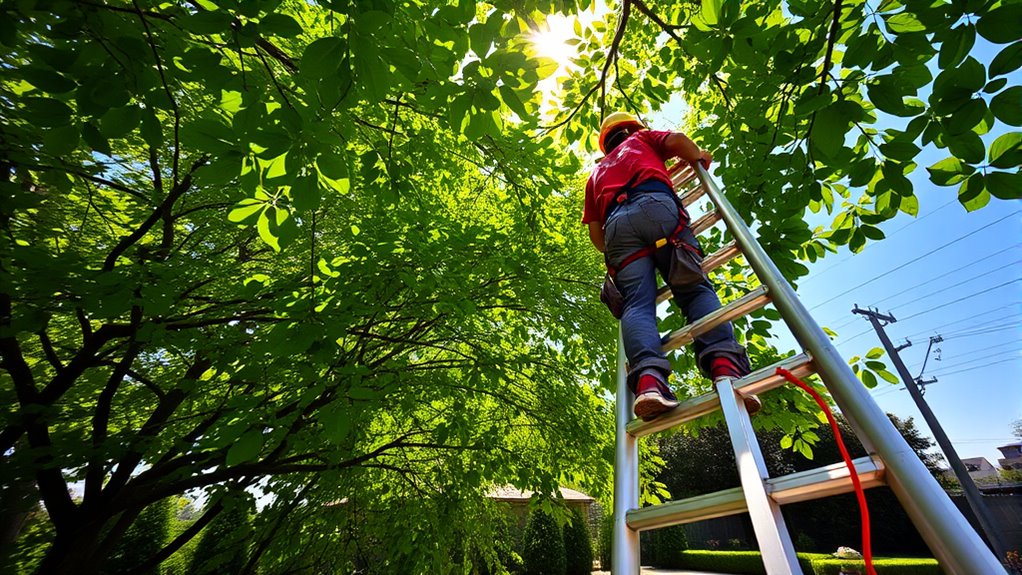
Before setting up a ladder, you need to check the ground stability and surface to prevent slipping or sinking. Weather conditions, like wind and rain, can make working unsafe, so monitor the forecast. Good lighting and clear visibility are essential to avoid accidents while working at height. Additionally, ensuring proper ladder stability by securing it on an even surface can significantly reduce the risk of falls.
Ground Stability and Surface
When setting up a ladder, evaluating the ground stability and surface is crucial to guarantee safety. A solid ground surface provides a stable base, preventing slips or tipping. Conduct a stability assessment by checking for unevenness, loose debris, or soft ground that could shift under weight. Here are key points to consider:
- Ensure the ground surface is firm and level to support the ladder’s weight.
- Remove debris or objects that could cause slipping.
- Avoid soft or muddy areas that may sink or shift.
- Use a level to verify stability before climbing.
- Be aware that surface conditions can change with weather, making regular checks essential.
Taking these steps helps prevent accidents caused by unstable footing. Always prioritize a thorough ground surface and stability assessment to ensure your ladder remains secure during use.
Weather Conditions and Wind
Weather conditions and wind play a significant role in ladder safety because they can change suddenly and create dangerous situations. Wind considerations are especially vital when you’re working at height, as strong gusts can destabilize your ladder or cause you to lose your balance. Weather impacts like rain, snow, or ice can make surfaces slippery, increasing the risk of falls. Always check the forecast before using a ladder outdoors, and avoid working in high winds or stormy conditions. Even moderate wind can sway a ladder or shift your position unexpectedly. If conditions worsen, it’s safer to postpone your task until the weather clears. Being aware of weather impacts and wind considerations helps you maintain stability and reduces the risk of accidents. Recognizing the signs of running dry, such as fatigue and dehydration, can also help prevent accidents related to physical exhaustion.
Lighting and Visibility
Have you ever considered how poor lighting or limited visibility can increase your risk of accidents on a ladder? Insufficient work illumination hampers your ability to see hazards clearly, increasing the chance of slips or falls. To guarantee safety, consider these factors:
- Check that the area is well-lit before starting work.
- Use portable work lights if natural light is inadequate.
- Avoid working in shadows or dark spots where visibility is compromised.
- Maintain clear, unobstructed lighting to enhance overall lighting visibility.
- Incorporate proper ambient sound awareness to stay alert to your surroundings, especially when visual cues are limited.
Proper lighting ensures you can see your footing, tools, and surroundings clearly, reducing accident risks. Good work illumination is essential for safe ladder use, especially in low-light conditions. Prioritize lighting to stay safe and work efficiently.
Essential Safety Gear and Precautions
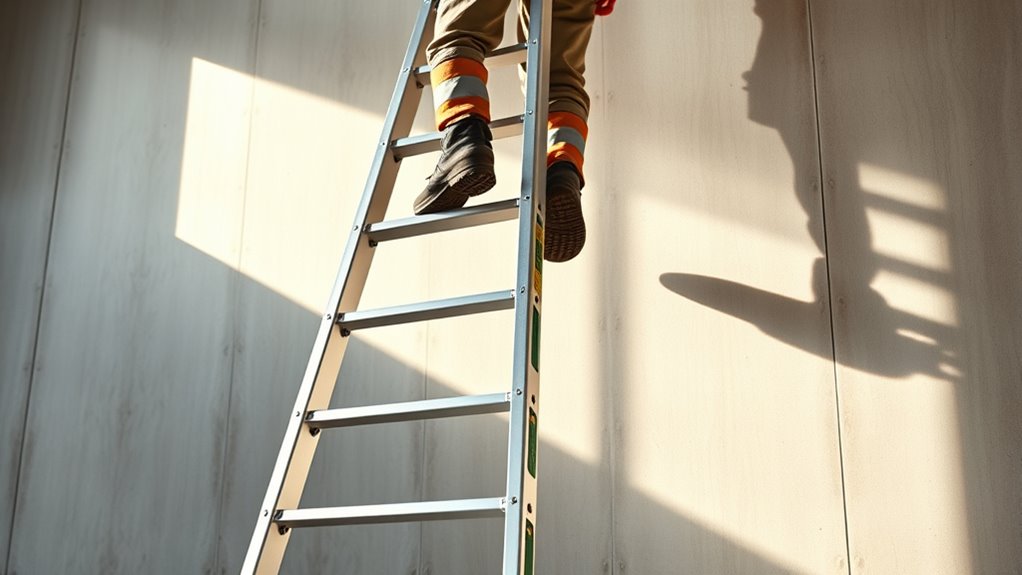
To make certain your safety while using ladders, it’s essential to wear the right protective gear and follow key precautions. Always equip yourself with personal protective equipment like gloves, non-slip shoes, and a helmet if working at height. This gear helps prevent injuries from falls or accidental contact with tools. Before starting, check your environment for hazards and make sure your ladder is stable. Keep a clear workspace and avoid overreaching. Additionally, being prepared for emergencies is imperative—know how to safely descend and have a plan in case of accidents. Proper safety gear combined with awareness and preparedness reduces risks markedly. Always stay alert, follow safety guidelines, and never compromise on protective measures to guarantee your safety while working on a ladder. Understanding city dynamics is also beneficial for planning safe ladder use in various environments.
Frequently Asked Questions
How Often Should I Replace My Ladder for Safety Reasons?
You should replace your ladder when its lifespan reaches the point where safety inspections reveal significant damage or wear. Regular safety inspection schedules, ideally every few months or after heavy use, help you identify issues early. Look for cracks, corrosion, or loose rungs. Even if your ladder appears fine, replace it if it’s over 10 years old, as materials degrade over time, increasing safety risks. Always prioritize safety over cost.
Can I Use a Ladder Outdoors During Rain or Snow?
Using a ladder outdoors during rain or snow isn’t safe due to rain safety concerns and adverse outdoor conditions. Wet surfaces can cause slips, and snow can make the ladder unstable. You should avoid using a ladder in such weather to prevent accidents. Always check the weather forecast before working outdoors, and wait for clear, dry conditions to guarantee your safety when using a ladder outside.
What Are the Common Mistakes to Avoid When Using a Ladder?
When using a ladder, avoid common mistakes like neglecting ladder stability and proper footing. Always verify the ladder is on a level surface and securely positioned. Don’t lean too far or overreach, which can cause instability. Check for damaged rungs or side rails before climbing. Maintain three points of contact and keep your body centered. These precautions help prevent falls and injuries, making your task safer and more efficient.
How Do I Store Ladders Safely to Prevent Damage?
Did you know that improper ladder storage can lead to 25% of ladder accidents? To prevent damage, focus on good ladder maintenance and use proper storage solutions. Store your ladders in a dry, sheltered place, away from foot traffic, and keep them upright or hanging securely. Regularly inspect for damage before storing, and avoid leaning them against harsh surfaces. Proper storage keeps your ladder safe and extends its lifespan.
Are There Specific Guidelines for Using Ladders on Uneven Surfaces?
When using a ladder on uneven surfaces, you need to prioritize ladder stability and surface assessment. First, check the ground to ensure it’s firm and level; if uneven, use ladder levelers or stabilizers. Always keep the ladder at the proper angle—about 75 degrees—and avoid placing it on loose or slippery surfaces. By carefully evaluating the surface and guaranteeing stability, you reduce the risk of accidents and maintain safe ladder use.
Conclusion
By understanding ladder types, evaluating your needs, and following safety tips, you can stay safe on the job. Always inspect your ladder and use proper gear—don’t cut corners or you might find yourself in hot water. Remember, safety isn’t just a suggestion; it’s your best bet to avoid accidents. Stay vigilant, because when it comes to ladders, it’s better to be safe than sorry. Keep safety at the top of your list!
